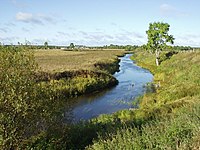
Photo from wikipedia
Abstract Velocity deficits resulted from boundary layers developing along walls in multiple-channel inlet of artificial ocean basins disturb the flow uniformity in the basin and are undesirable. Experimental tests on… Click to show full abstract
Abstract Velocity deficits resulted from boundary layers developing along walls in multiple-channel inlet of artificial ocean basins disturb the flow uniformity in the basin and are undesirable. Experimental tests on a uniform and a simple shaped honeycomb at Reynolds number R e h = 3.8 × 105 in a wind tunnel show the possibility of eliminating the velocity deficit by using a shape-optimized honeycomb with gradual change of thickness. Inspired by the results, the present study develops a systematic and efficient method to design the shaped honeycomb to improve the flow uniformity. The method comprises of optimization process based multi-fidelity numerical simulations and precise experiments. Firstly, with the test results as validation, a numerical algorithm based on the “porousSimpleFoam” solver of OpenFOAM® is developed to optimize the shape of the honeycomb using low-fidelity 2D simulations. High-fidelity 3D simulations are also performed to verify the optimized solution. The optimized honeycomb is then fabricated using 3D printing technology and validated experimentally in the wind tunnel. By applying the optimized honeycomb, the velocity deficit is significantly mitigated. The coefficient of variation, i.e. ratio of the standard variation to the mean velocity, is reduced from 6.61% to 1.55% at R e h = 3.8 × 105. The optimized honeycomb performs well at lower Reynolds numbers too. At R e h = 1.9 × 105 and 9.5 × 104, the coefficients of variation decrease from 7.13% and 8.25% without the honeycomb to 1.87% and 2.11% with the honeycomb, respectively.
Journal Title: Applied Ocean Research
Year Published: 2019
Link to full text (if available)
Share on Social Media: Sign Up to like & get
recommendations!